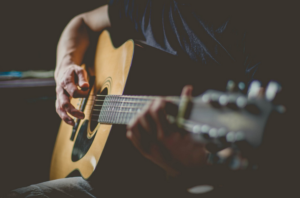
Playing guitar is a lot of fun. However, you should also consider maintaining your guitar. To guide you, you must always clean the body of your guitar to keep its shape. It’s also great to know that you’re improving your skills and learning new things, even though it might not always seem like it! In this article, we will be discussing how to play the chords on the guitar. We’ll cover some basics, as well as some more advanced tips and tricks for those who want to improve their skills and learn something new about playing the guitar.
Practice the Chords and Strumming Patterns
 Practice playing chords and strumming patterns. It is essential to practice these things a lot. You should also start learning songs that you like because it helps make the experience more enjoyable while practicing your skills! Practice makes perfect, so you will see yourself getting better with every practice session. Playing chords and strumming patterns is a great way to start because it helps make your playing more interesting. Playing them correctly can be difficult at first, though! If you notice that the chord or pattern has been misplayed, go back and try practicing these things again.
Practice playing chords and strumming patterns. It is essential to practice these things a lot. You should also start learning songs that you like because it helps make the experience more enjoyable while practicing your skills! Practice makes perfect, so you will see yourself getting better with every practice session. Playing chords and strumming patterns is a great way to start because it helps make your playing more interesting. Playing them correctly can be difficult at first, though! If you notice that the chord or pattern has been misplayed, go back and try practicing these things again.
Learn the Basics
Before you go and buy a guitar, it’s essential to learn the basics. If you want to make your purchase worthwhile, take some lessons first and a master at least chords A through G. By doing this, you will have a solid foundation to build upon. It would help if you also learned how to properly hold the guitar and some of the most common chords. If you want, take some lessons first so you can get off on the right foot when it comes time for your purchase!
Experiment With New Chord Combinations
 Start by playing two or three strings at a time instead of all six. This will allow you to get used to chord transitions while still making music. Once your fingers have loosened up, try the same thing but this time using more complex combinations and switching chords more often. Experiment with different strumming techniques – maybe play one chord per beat or double up the strums, for example.
Start by playing two or three strings at a time instead of all six. This will allow you to get used to chord transitions while still making music. Once your fingers have loosened up, try the same thing but this time using more complex combinations and switching chords more often. Experiment with different strumming techniques – maybe play one chord per beat or double up the strums, for example.
When you’re first starting with your chord playing, it can be helpful to visualize them on a piano keyboard rather than six strings – this way, every combination will seem familiar and accessible once you’ve learned where they all are. It would help if you also tried learning each chord in multiple positions on the fretboard – this will help your chord movement and make playing a lot easier.
Don’t be afraid to try out new chords or different ways of voicing them – you might surprise yourself with how easy some complicated chords are once you get used to finding the notes. Experimentation is key here!


